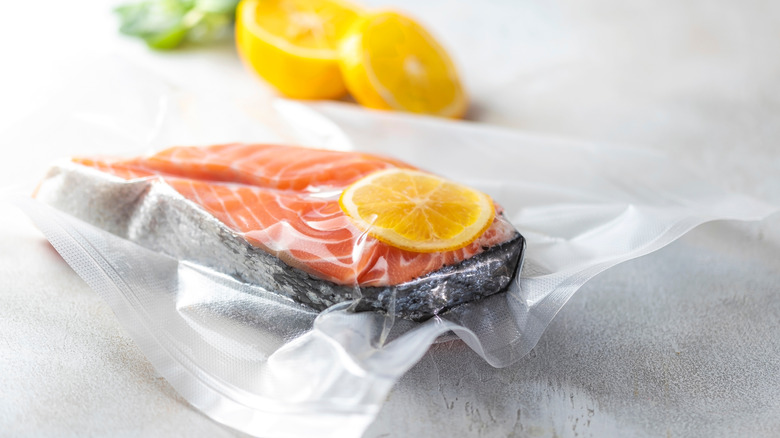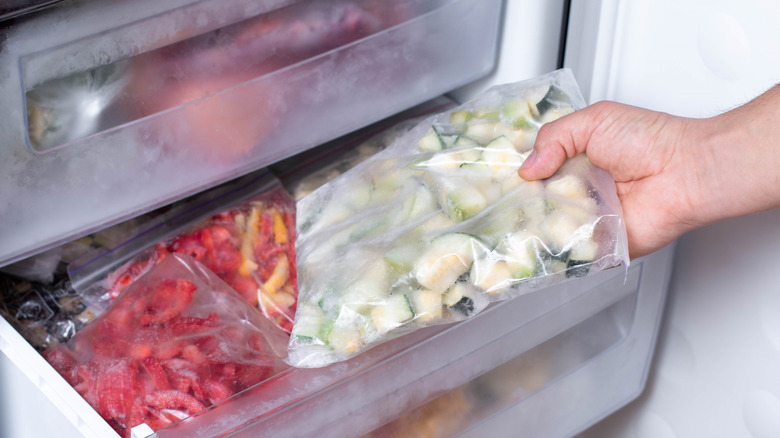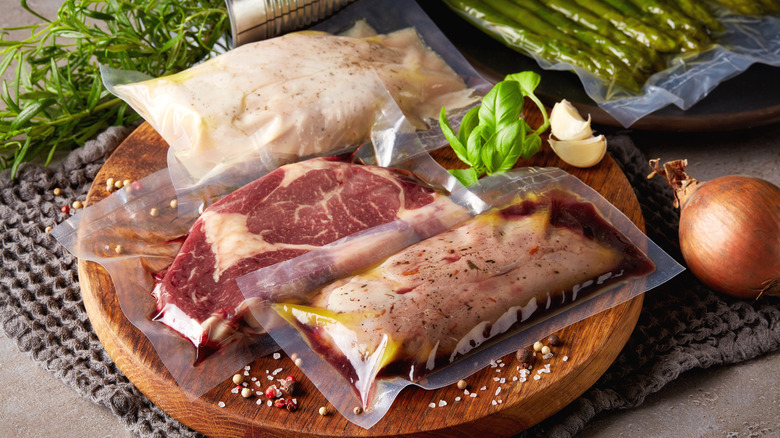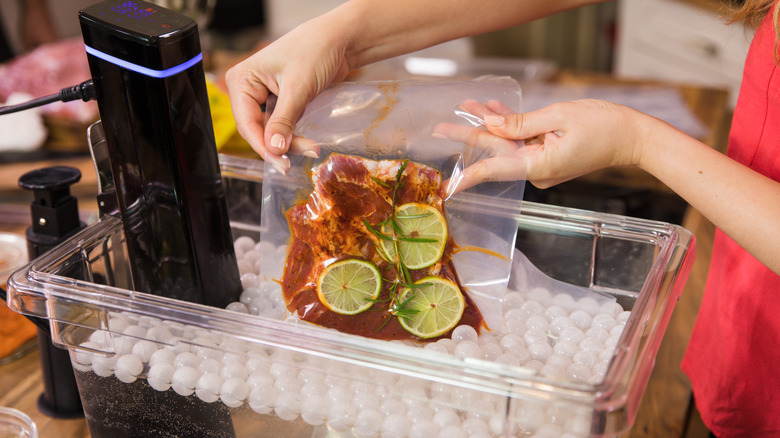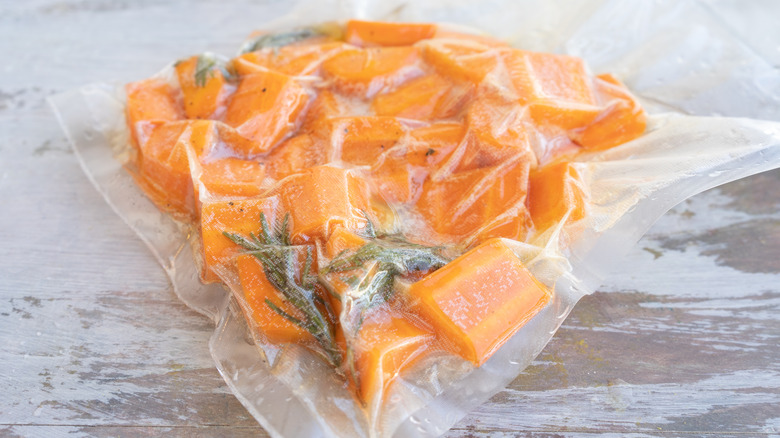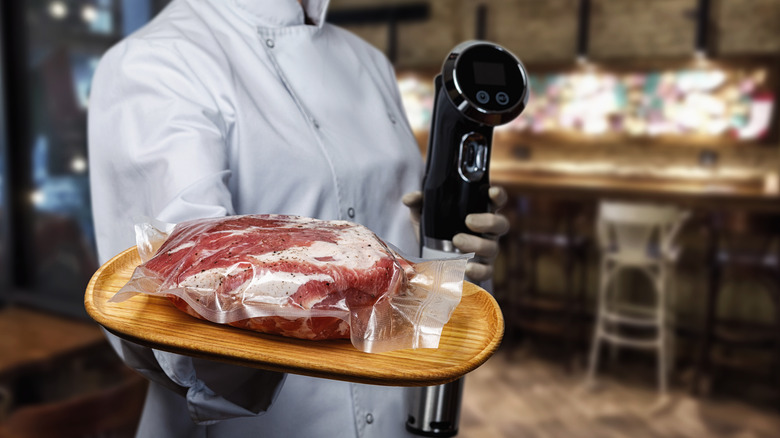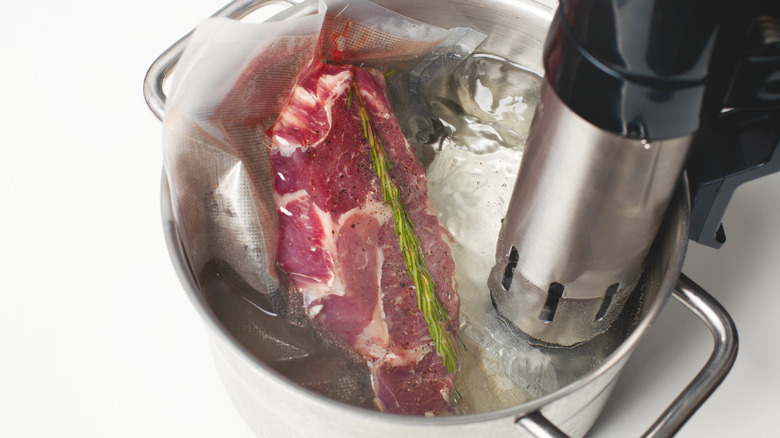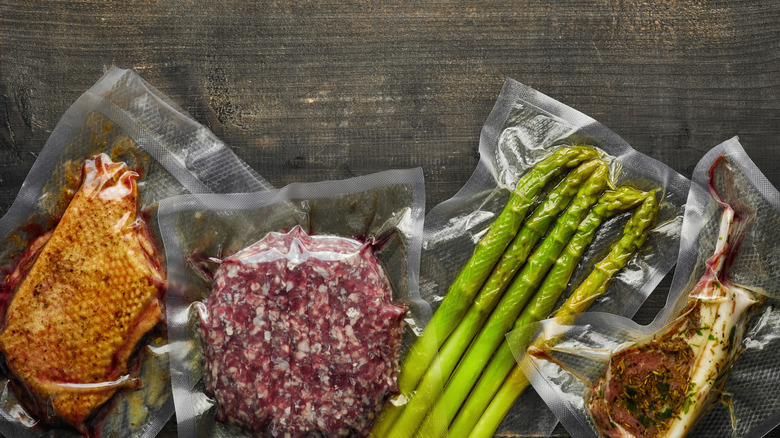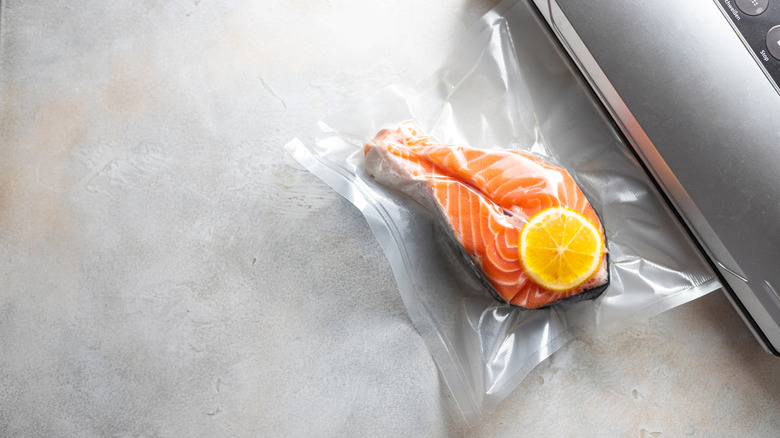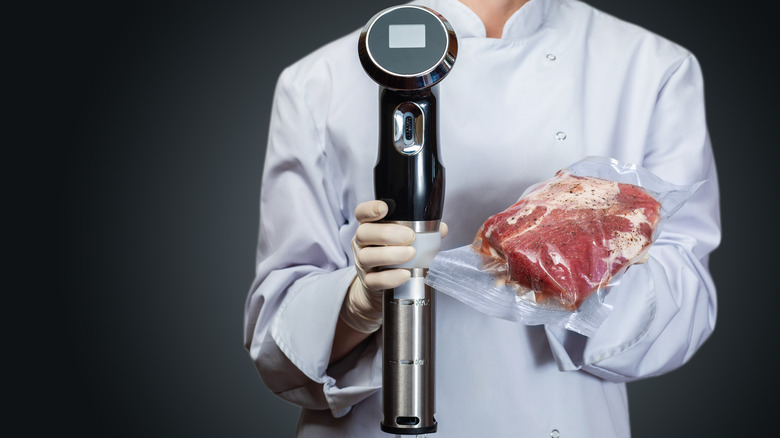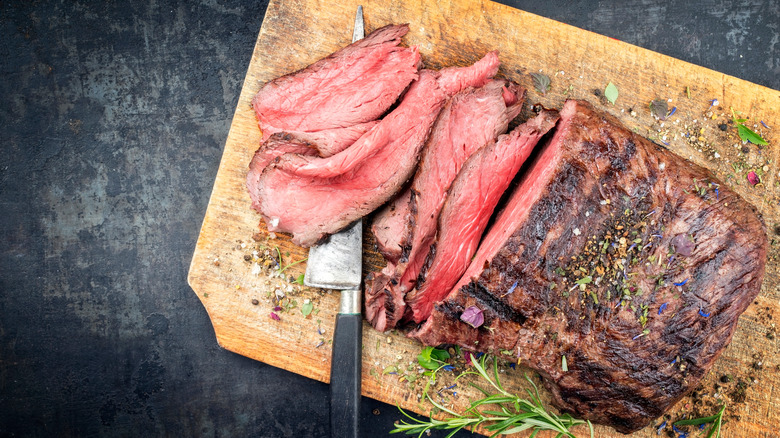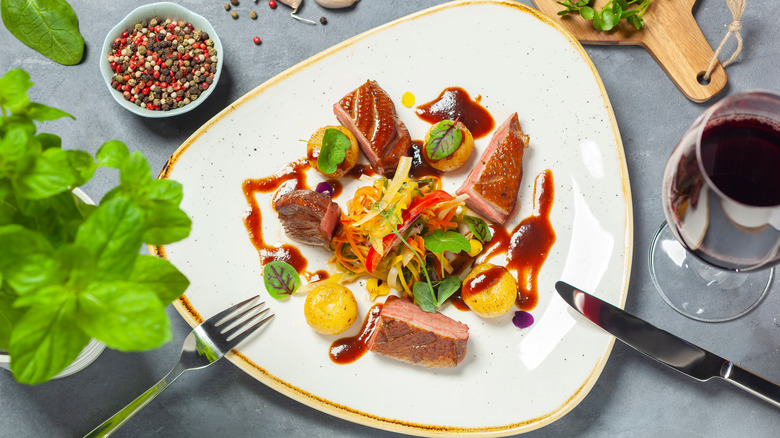Sous Vide Myths You Can Officially Stop Believing
Sous vide cooking is having a moment, and it's not hard to see why. Meat, eggs, and veggies that have been cooked with the sous vide method often come out tender, juicy, and moist, making every bite taste like it's melting in your mouth. Plus, it's more of a hands-off process than many cooking methods out there, which means it can be convenient for people who lead busy lives but who still love home-cooked meals.
But whether you sous vide dishes every day or are yet to jump on this trend, there's a good chance that you still believe some of the more prevalent sous vide myths out there. That's okay — not all of these mistakes will make or break your dinner. But knowing what some of the most common sous vide myths are and learning how to avoid them is essential if you want to better your sous vide technique in the kitchen. We've compiled a list of some of the sous vide myths you may still believe, and we've tried to clear up any confusion. Take a look at these myths, and then get cooking. You'll feel confident that you know exactly what pitfalls to avoid the next time you turn on your immersion cooker.
1. You're basically just boiling your food in a bag
When people think about sous vide cooking, they often think about those boil-in-bag vegetables that used to be everywhere in the freezer aisle of your local grocery store. However, as per Healthline, we now know that cooking food in plastic can cause the plastic to leach, releasing dangerous chemicals into our foods. And that's the last thing any of us want. Therefore, it may seem like sous vide cooking should be off-limits. Aren't you just boiling your food in a plastic bag?
But SousVideTools assures us that it's not a problem because you're not going to be placing your food in boiling water. When you sous vide an ingredient, it cooks for a longer time at a lower temperature. Additionally, you should make sure that you're using bags specifically meant for sous vide cooking. These bags won't be filled with BPAs or other dangerous chemicals that could leach into your food. Plus, ingredients you sous vide will taste way better than the stuff you boil in a bag.
2. It's okay to vacuum seal food that's at room temperature
We all know that placing food in boiling water can kill bacteria, which is essential for cooking, especially when bacteria-prone meats and ingredients are involved, per the Centers for Disease Control and Prevention. But remember: When you sous vide, you're not actually placing your food in boiling water. Because of that, you're going to want to take some extra safety precautions to ensure you don't put yourself and your family at risk of food poisoning.
This is why the Sous Vide Guy says it's so important to only vacuum seal cold food. While you may think it's okay to thaw some frozen meat on the counter, leave it at room temperature, and then start to sous vide it, that's not a great idea, as bacteria can begin to grow when your food gets too warm. And since you're cooking at a lower heat than you might with other cooking methods, putting room-temperature meat into a vacuum-sealed bag can be a recipe for disaster. The solution? Thaw ahead of time, and then place your chilled food directly into the plastic bag to sous vide. It might take a bit of extra time and forethought, but your food will be safer for it.
3. Sous vide cooking is the only method you need
We get it: You sous vide an egg, a steak, or a nice hunk of pork once, and it tasted amazing ... like really, really amazing. And suddenly, you think that sous vide is the only method you'll ever need to use in the kitchen again. While we certainly support you cooking this way as much as you want, the truth is, it's never going to replace other cooking methods entirely. According to Digital Trends, sous vide cooking results in a much different texture than you're used to with other cooking methods. And for some foods, that just doesn't work out too well.
For example, while sous vide cooking can get your meat nice and tender on the inside, it's not going to give it that signature sear that you're looking for a lot of the time. If you love your veggies nice and crisp with a little bit of a blackened edge to them, you're better off roasting in an oven, not cooking in an immersion cooker. And you're not just going to forget about the convenience of a microwave when you want to poach an egg quickly, are you? If you're like us, sous vide cooking has a place in your kitchen, but it's not the only method that yields favorable results.
4. You can only sous vide meat
What first comes to mind when you think of sous vide cooking? If you're like many people, you probably think of perfectly cooked chicken, steak, or pork. And an immersion cooker will indeed do that extremely well. But if you want to get the most out of your sous vide skills, you shouldn't stop at meat. As Sous Vide Tools reminds us, there are many delicious ingredients you can place in your immersion cooker for fantastic results.
Eggs are one of our top choices when it comes to sous vide-able ingredients, and that's because cooking them is nearly foolproof. In fact, if you haven't tried it yet, stop reading this right now and fire up your sous vide — you can thank us later. Sources of protein aren't your only option, though. Tough, cruciferous veggies like kale and broccoli and root veggies like carrots also do well in an immersion cooker. But keep in mind that they'll have a much different flavor and texture than they would if you were to cook them on the stove or in the oven.
5. Sous vide cooking requires a high skill level in the kitchen
When you see someone sous vide cooking for the first time, it may seem intimidating and hard to replicate at home. Honestly, it can look pretty unnerving, especially if you don't consider yourself a world-class home chef. But that intimidation shouldn't prevent you from trying something new, especially if you love the way sous vide-cooked food tastes. Best Sous Vide Recipes says that though it may seem complicated, most people can manage without too many issues.
First, make sure you have the right equipment, whether that involves a state-of-the-art immersion cooker or a pot, some water, and a thermometer. Familiarize yourself with how the process works by watching videos online and reading the instructions for your machine, if applicable. Then, just give it a try. Most people learn best by doing, and once you give sous vide cooking a shot, chances are, you'll see how simple it is.
Our advice? Start online and search for easy sous vide recipes that don't require many ingredients or a lot of different steps. Then, as you practice, you'll grow your skills so you can sous vide whatever your stomach desires.
6. It's not important to ensure your food is fully submerged in water
If you're new to sous vide cooking, you may not realize how important it is to ensure your food is fully submerged in water. After all, how bad could it be if a portion of your chicken thigh is sticking out of the water? As it turns out, really bad. Chelsea Cole of A Duck's Oven and founder of Sous Vide School told Tasting Table that this could cause significant problems. "If it's not fully submerged in the temperature-controlled water bath, the piece sticking out of the water will be cooked differently (and worse!)." That chicken, for example? If some of it is sticking out of the water, that part may not get cooked all the way through, which could potentially put you at risk of food poisoning or food-borne illness. That's not what you want when you're just trying to enjoy your meal.
Luckily, there are solutions. Cole says that silicone-coated sous vide magnets can help keep your food underwater, ensuring that every bit of your meal is cooked all the way through to perfection. Even easier, you can place a bowl or plate on top of the food to hold it down. We love a simple solution!
7. A vacuum sealer is key to sous vide cooking
If you see home cooks sous vide cooking online, you'll generally see them using a vacuum sealer for their ingredients before placing them in their immersion cookers. Vacuum sealers are a big help when trying this cooking method, but you may not realize that they're unnecessary in most cases, per Best Sous Vide Recipes. A lot of the time, you can get away with simply buying the necessary sous vide bags and pushing the air out of them as much as you can. You won't get that tight seal as you would with a vacuum sealer, but the result will be much the same.
This is great news for people who don't want to invest a ton of money into trying sous vide cooking and those who don't have a ton of counter space in their kitchens. Sous vide cooking can already be enough of a project in and of itself, so it's a relief knowing you don't have to buy several gadgets to get the job done. However, if you do find yourself sous vide cooking a lot, a vacuum sealer might come in handy.
8. You need hours to cook to sous vide anything
Whenever you try out a new cooking method, it can seem like it'll take hours to cook whatever you have in mind for dinner. And for a lot of us, that's not reasonable as we attempt to juggle busy schedules. Sous vide cooking, in particular, can seem like it will always require lengthy cooking times. While this may be true for some ingredients, it's not for others. In fact, SousVideTools tells us that many proteins, like chicken, fish, and steak, can all be cooked in under an hour. We bet you've spent that much time just tending to food in the oven, so sous vide cooking shouldn't be too far outside the realm of reason.
Plus, one of the benefits of sous vide cooking is that it's very hands-off. Once you place the food in the immersion cooker, you won't have to keep checking on it or adding anything to it to ensure it doesn't burn. Just let the water do its thing, and you'll be eating your juicy, tender chicken or fish in no time.
9. You have to buy expensive equipment to sous vide
Okay, this one does come with a caveat: If you're going to be sous vide cooking at home on the regular, then it's true that you'll probably want to invest in an immersion cooker. However, you may be surprised to learn that it's not at all necessary in the beginning. ChefSteps offers an overview of how you can create a sous vide setup in your kitchen with little more than a pot, some water, a thermometer, and a plastic bag. (We recommend swinging for the slightly more-expensive sous vide bags than the typical Ziploc bag.)
If you don't want to go through all that hassle, that's understandable, but it doesn't mean you have to pay a fortune in sous vide equipment. As this cooking style becomes more popular, more and more accessible immersion cookers are coming onto the market all the time. You can find immersion circulators for about $100 online at the time of writing, so it may be worth it to invest in one if you think you'll use this method a lot.
10. It's impossible to overcook your food when you're using the sous vide method
One of the best things about sous vide cooking is that you're cooking your food slowly. This allows meats and veggies to hold onto their juices more, so you're left with a luscious, moist meal that will make your mouth water. But another benefit is the fact that it's a lot harder to overcook your food than it would be when you're, say, cooking on the stove. However, you shouldn't believe the myth that it's impossible to overcook your food when you're using the sous vide method.
Best Sous Vide Recipes says it's entirely possible to overcook your food in an immersion cooker. Luckily, you're not burning anything, but overcooking ingredients could lead to an undesirable texture. Unsurprisingly, fish and chicken are the main ingredients you'll have to worry about when it comes to overcooking. Be sure that you set a timer, so you don't forget to pull your food out of the cooker when the time comes.
11. You need to use a lot of salt and seasoning
If you like to cook, you may be used to sprinkling your food with healthy doses of salt and other seasonings throughout your cooking process. This is especially important when you're cooking on the stove, as many of those spices and herbs stick to the pan, rendering them ineffective for actually flavoring your food. However, you have to remember that you're not dealing with the same situation when you're sous vide cooking, so it's a myth that you need to use tons of seasoning before you place your meat, eggs, or veggies in a plastic bag.
Digital Trends reminds us that when we place those seasonings in a bag, they have nowhere to go but into our food. Therefore, over-seasoning can lead to too-salty or otherwise unpalatable food, which probably isn't what you're going for. The first time you sous vide, think about going light on the seasoning and adjusting accordingly as you learn more about what you like.
12. Sous vide recipes are boring and unimaginative
If there's one myth in this bunch that needs the most busting, it's this one: Sous vide recipes are basic, boring, or otherwise lacking in flavor or personality. Of course, just about any cooking method can result in bland food. Some cooks will make average sous vide-cooked food, while others can work their magic and turn their ingredients into something fabulous.
When you're first starting with your sous vide cooking journey, you may be consulting pretty basic recipes to help you get the formula down right. But once you've learned how to do the basics, you can start seeking out more interesting sous vide recipes or try your own. And don't be afraid to combine the immersion cooker with other cooking methods for one dish. Sous vide cooking is a great way to reach the perfect internal consistency before throwing a piece of meat on the grill, on the stove, or in the oven to achieve the nice sear or crisp crust you're looking for.
There is a reason why sous vide cooking is so popular, and that's because it can result in absolutely delicious meals. Don't write it off before you give it a try for yourself with your favorite recipes.
